
Species Traits
TEXT GUIDES:
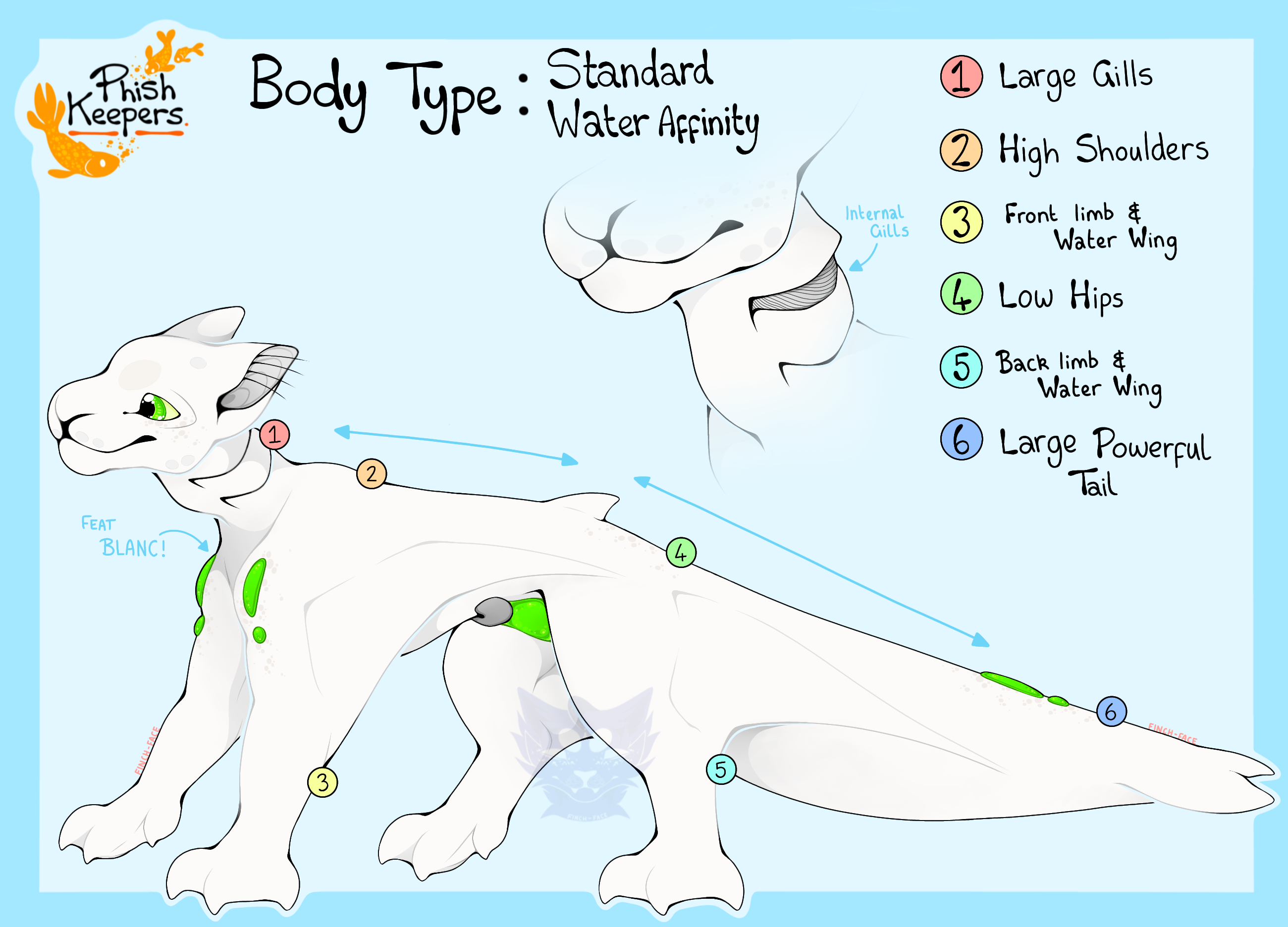
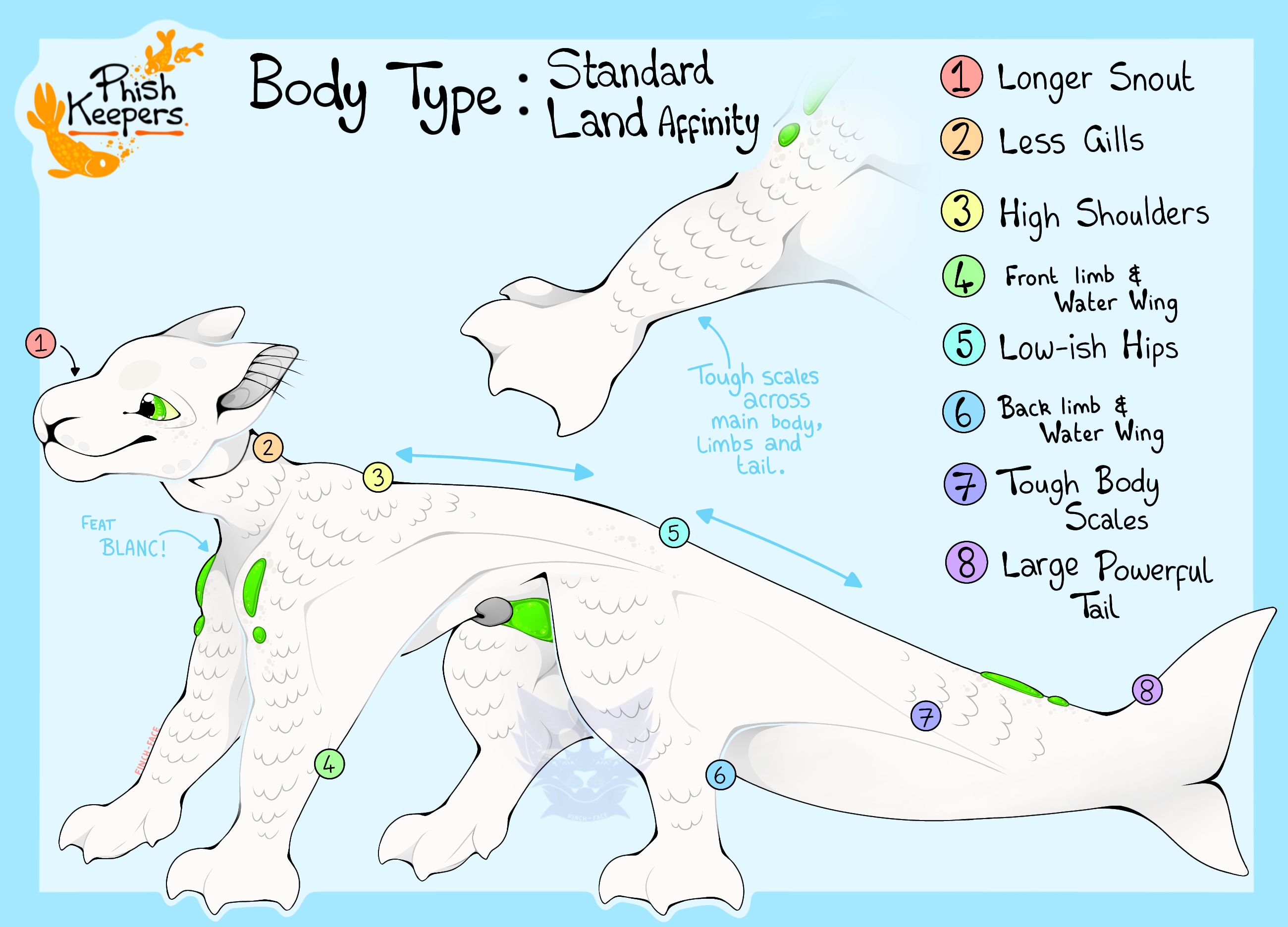
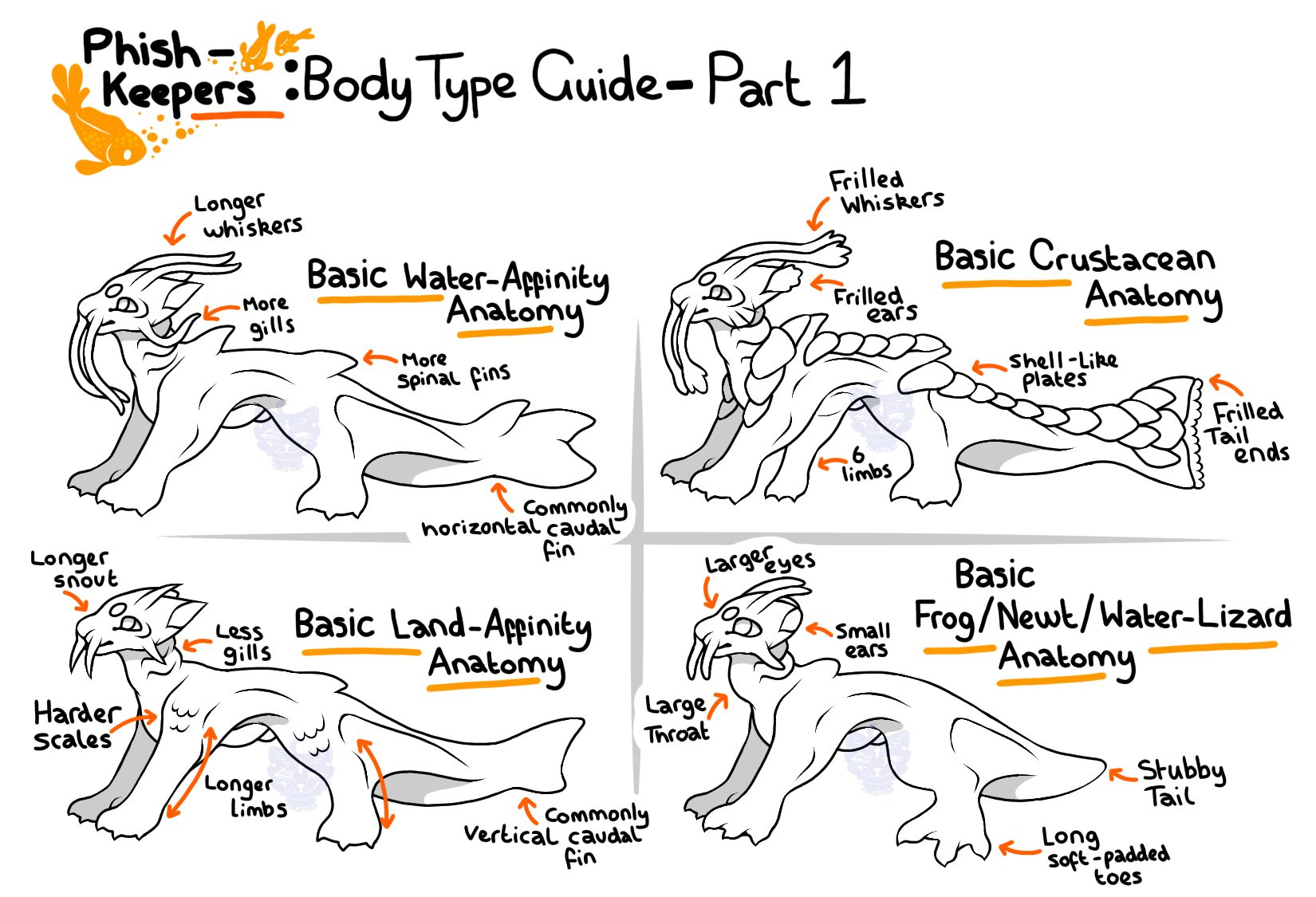
bODY tYPE
Standard Water-Affinity Type:
The most common body type for Phish-Keepers. Key features include:
- A long, slender body
- Mid-length fore-limbs (about half the total length of their main Body and Tail)
- A sloped spine with shorter back-limbs
- Long facial feelers
- Typically more Gills/Gill lines (between 2 and 6 located on the Neck region)
- Typically more spinal fins (though this can depend on Companion as well)
- Typically Horizontal Caudal fin (at the base of the tail (though this can depend on Companion as well))
Most commonly formed with a Standard/Middle sized Fish, Sharks, Dolphins and small Whale companions.
Standard Land-Affinity Type:
This body type is the closest to the Standard Water-Affinity Type, with only a few differences. These include:
- Less Gills/Gill lines (between 2 and 3 located on the Neck region)
- Longer snouts (due to their larger air Lung capacity and greater amount of time spent above Water)
- Harder scales (this helps protect them out of the Water from both Sunlight and Predators/Injuries)
- Longer limbs (Help them to travel longer distances without needing to break)
- Typically Vertical Caudal fin (at the base of the tail (though this can depend on Companion as well))
Most commonly formed with a Crocodilians, Large Water reptiles, and Alligators companions.
Basic Crustacean Type:
A major variant of the Standard Water-Affinity Type, with significant mutations and anatomical differences. These include:
- A greater number of limbs (Typically between 1 and 3 pairs of fore-limbs, with Water-wing membrane between each wrist and the next)
- Frilled facial feelers
- Horizontal Caudal fin with frills on the underside
- Shell-like Scale plating covering the tops of their body (can vary greatly depending on Companion)
- Crustacean only Mutation! - Floppy Scale-played ears with frills at the ends
Most commonly formed with Crab, Lobster, Shrimp, Horseshoe Crabs, Clams, Oysters & other Shellfish, Arthropod and Isopod companions.
Basic Frog, Newt, Water Lizard Type:
A major variant of the Standard Water affiliated Type, with a few main mutations and anatomical differences. These include:
- Larger eyes and Skulls
- Larger throats and Throat Sacs (allow them to produce small croaks, chirps and whistles)
- Small ears (usually the Nub, Button or Small rounded type (though this can depend on Companion as well)
- Longer back-limbs with soft-padded toes (helps them to grip to surfaces and allows for greater climbing capabilities)
- Stubby tails (usually without a significant Caudal fin (though this can depend on Companion as well))
- More likely to be a Pygmy variant than other P-K types
Most commonly formed with a Frogs, Newts, Salamanders, Sailfins, Monitors, Basilisks and other various water reptile companions.
P-K Size
Phish-Keeper size is directly correlations to the normal size of their companion. For example, if a P-K has a Guppy as a companion, their total size will be a lot smaller than a P-K that has a Shark as a companion. This is because the total space needed by the Companion is greater if the Companion is larger, than that of smaller ones.
(Any creature under 1 foot in length tends to cause the P-K to be a Pygmy type)
P-K can be any size between 2 foot (0.6 metres) total length and 250 feet (roughly 76 metres) total length.
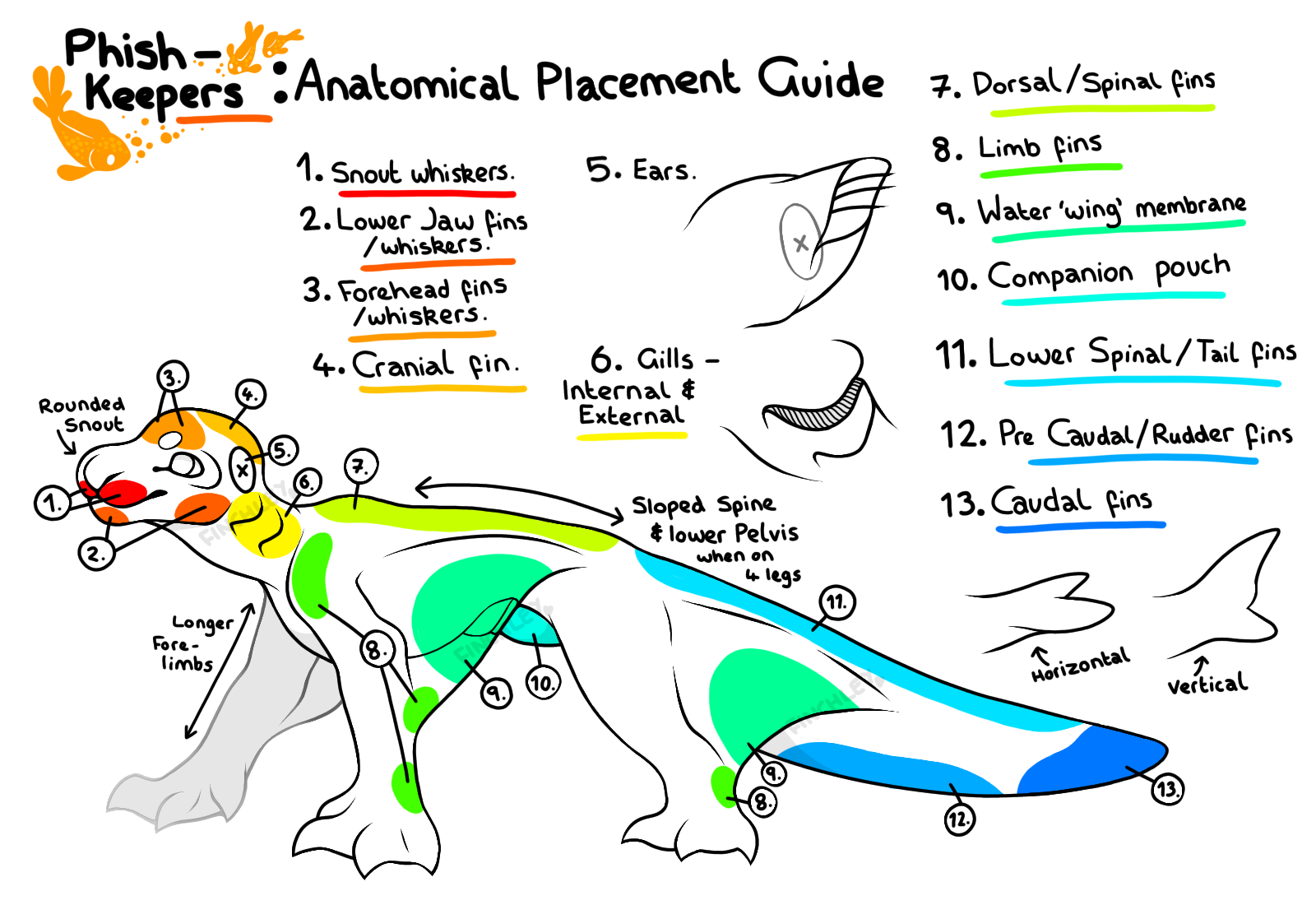
anatomy
1. Snout Whiskers - Labelled in Red
Whiskers and other whisker like protrusions form over the upper lip and act as feelers, sensing both physical objects and electrical currents in front of P-K in water.
2. Lower Jaw Fins / Whiskers - Labelled in Dark Orange
Similar to the snout whiskers, though usually either longer in length or more intricately formed. These whiskers or fins have the same functions, except that they feel things behind the P-K instead of in front.
3. Forehead Fins / Whiskers - Labelled in Orange
Though these fins look the same as both other sets, they are more for emotional use instead of sensory. They are the most flexible and maneuverable of all the fins, and are used in greetings or displaying changing emotions.
They can be pivoted in a wide range of motions to display different emotions to other P-K. For example, having them folded down to rest against the skin is a sign of Fear or Stress, where as having them stand upright or wiggle is a sign of Happiness, a Greeting or to show they mean no Harm to others.
4. Cranial Fins - Labelled in Mid Yellow
Main head fin, that an grow between the forehead and the base of the skull on a P-K. This Fin can be used to help breach the surface of the ocean and make sharp turns.
5. Ears - Labelled in with a Circle and x
Attached smoothly to the back of the head, and have an extensive range of movement. They flatten completely against the side of the skull when swimming full speed to create less resistance, and have a large array of flick patterns centred around their mood or personality.
Twitchy ears equals happy Phish-Keeper!
6. Gills - Internal and External - Labelled in Yellow
P-K are classed as Amphibious Reptiles, and primarily breathe with their Water lungs. They usually have between 2 and 5 pairs of gills on either side of their neck, which flare outwards in water to allow the biggest surface area for the Internal Gill to process air from the Ocean, and flatten skin tight when out of water.
7. Dorsal / Spinal fins - Labelled in Lime Green
The most solidly built fins on a P-K’s body, these fins can develop into standard dorsal style fins, webbed lines or a mix of different types depending on the companion animal.
8. Limb Fins - Labelled in Bright Green
Though they don’t have much functional use, these fins are common among P-K, although not every P-K seems to have them. Varies from P-K to P-K.
9. Water‘wing’ Membrane - Labelled in Mint Green
A large expanse of moderately thick, elasticated skin that stretches between both limbs and the main body / tail. When trying to slow down or turn, the P-K will extend it’s legs outwards, away from the body, and this causes the stretched out ‘wings’ to bulge behind it, creating a high amount of resistance.
Imagine a parachute filling with air after being deployed, these wings work in the same way and are used to create resistance & drag in the water when a P-K is moving at speed, allowing them to create sharp turns without much effort.
10. Companion Pouch - Labelled in Light Blue
The companion pouch of a P-K is a - roughly - Rugby ball shaped pocket made of elastic, stretchable skin that houses the Companions of said P-K when they sleep or are facing something dangerous.
Each pouch has an Upper and Lower Lip, that are usually a brighter colour than the main Pouch, situated at the top and bottom of the pouch itself. These are made up of a tougher, more heavily scaled skin that acts as protection to the pouch and can cushion The bottom Lip is attached firmly to the body of the P-K, and holds a small amount of extra skin that can be stretched to accommodate the Companion if they want to use the pouch as a resting spot.
The upper Lip is detached from the body, and is both the entrance and exit for the Companion.
11. Lower Spinal & Tail Fins - Labelled in Blue
12. Pre-Caudal / Rudder Fins - Labelled in Mid Blue
13. Caudal Fins - Labelled in Dark Blue
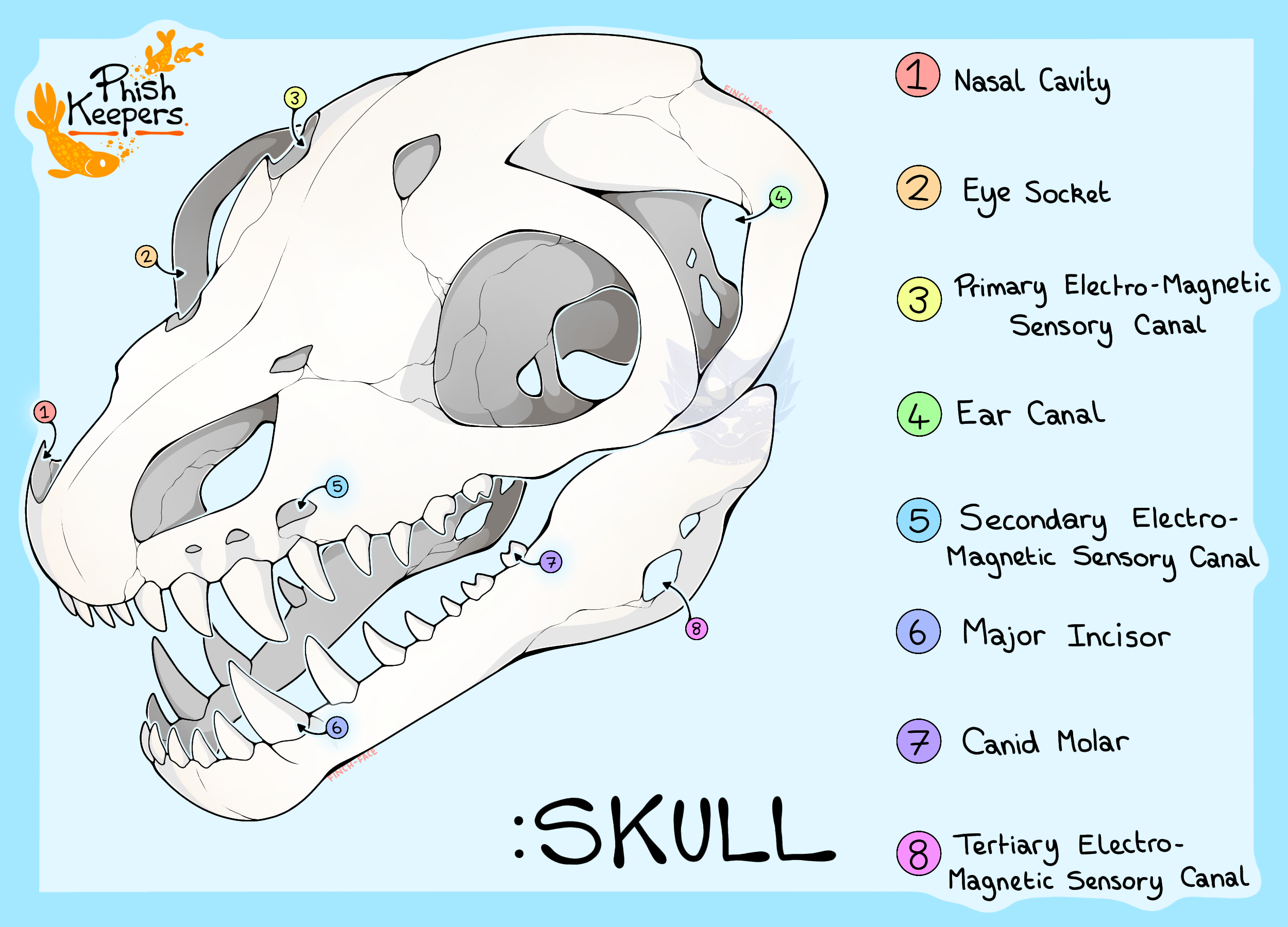
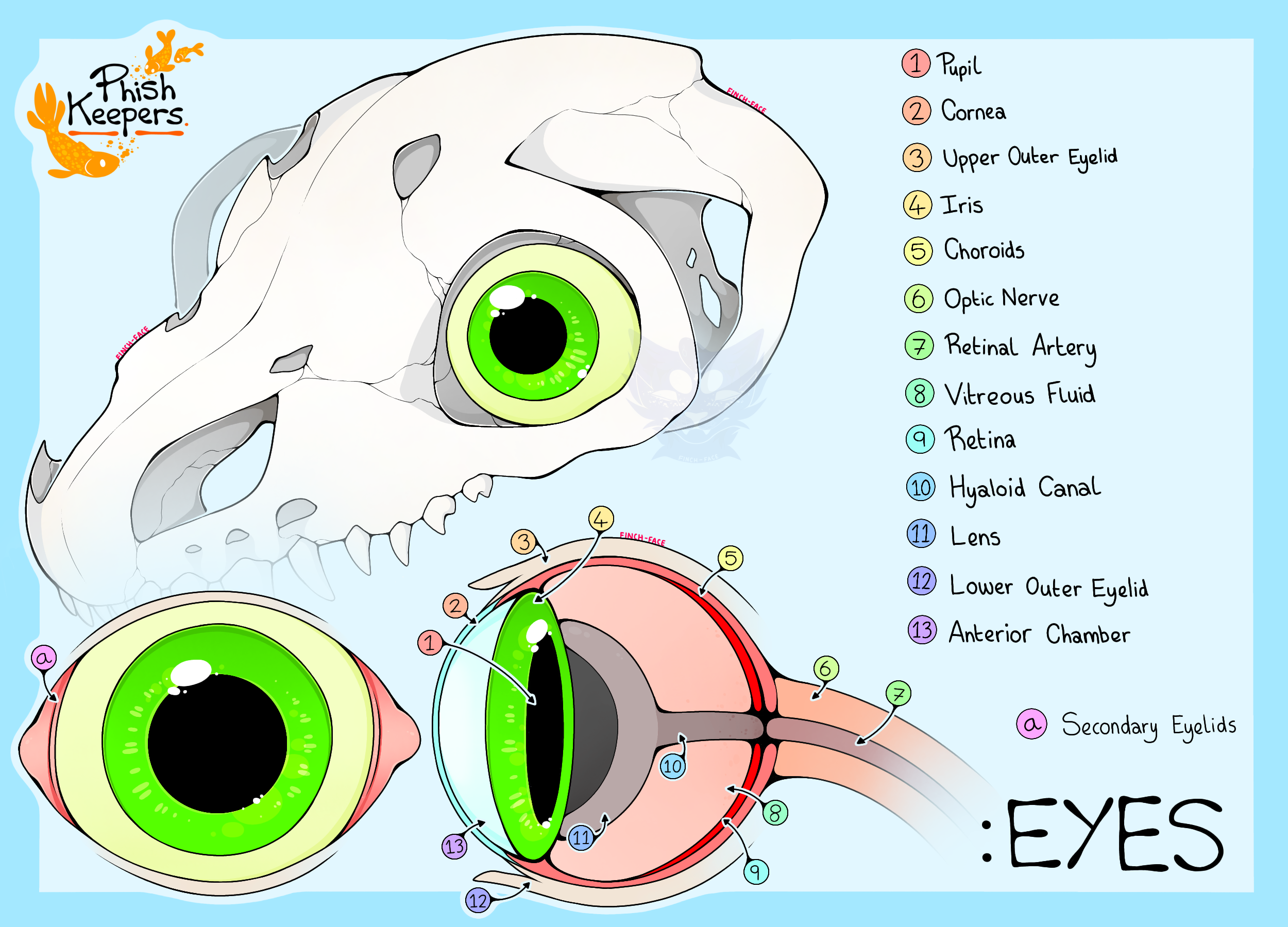
HEAD ANATOMY
SKULL:
A P-K skull is a lot more slender than their outer face may make it look, with a smooth jaw line and slight convex curve to the top of the cranial bone (On standard and Pygmy face types, though this skull curve is concave on the Sloped face type). Their more curvy facial appearance is made so by the heavily packed nerve endings and central nerve lines connecting to their facial feelers, which takes up more room and makes their faces look fuller and more rounded, also amplified by their scales that layer on top of their muscle mass.
P-K’s have an average of between 16 & 26 teeth, depending on their size, skull shape and diet, though this number can shrink or grow depending on a P-K’s companion type. They regularly grow new teeth if their other ones are damaged or knocked out. These teeth come in 2 types, being the Incisors and Canid-Molars.
Similar to the structure of dinosaur teeth, the Incisors of a P-K are small in the front, getting larger towards the front corners of the mouth which jar or the largest Incisor, before tapering back down into smaller Incisors in the middle of the upper and lower jaw bone. These Incisors are deadly sharp, and are used to grip onto prey and can tear through solid bone.
Behind these teeth are 2 pairs of Canid-Molars; a flatter type of tooth with one pointed edge facing towards the sharper teeth, allowing for both chewing and cutting motions.
Having both types of teeth offers a wider variety of food options to P-K, including plant life, fruits and seeds, giving them an Omnivorous appetite, though most P-K are natural Carnivores.
P-K have a pair of large nasal passages at the front of their face, though the reasons for these are not certain. It is believed to be a trait born out of necessity, that allowed them to both intake more oxygen when moving on land and help them seem more predatory like the bigger canids and delicate they lived alongside when they were land bound.
With independent sets of muscles that tightly secure the nose slits shut when in deep water, P-K evolved to keep their oxygen lungs and nasal passage as well as their Gills and water lungs instead of evolving out of it, becoming an amphibious reptilian species.
EYES:
Phish-Keeper eyes are relatively large in terms of total head size, taking up roughly 1/4 of the total skull space, and are cushioned with a sizeable curved portion of cheekbone that has small pockets within the bone. These pockets - a small space at the back of the eye socket and 2 small indents underneath the eyeball - help to protect the eyes from injury, rapidly stopped movements and absorb shocks. The space at the back of the eye is padded with small muscle groups, that help to cushion the eye within the socket in the event of a fight or attack.
The eye structure of P-K’s shares a lot of similarities with marine mammals, with the basic shape and structure being almost identical. However, they have a modified lens that is spherical instead of elongated, allowing for a better range of focal points and easier sharpening of vision that helps them see well both on land and in water. Pupils can vary greatly in size, and are naturally large, giving Phish-Keepers very sharp night vision and the ability to quickly assess visual images in differing distances and focal ranges (both in and out of water).
P-K pupils can vary in shape greatly, and are often dependant on the companion type that they have. All P-K pupils start off round, but go through a rapid stance of mutation when they first develop their companion mimicking traits. Usually a P-K has 3 cones in their eyes, meaning they have decent colour vision that covers Yellow, Green and Blue for the most part, however some P-K have been studied to have 4 cones depending on how greatly they favour land living over water living.
In front of the Pupil is a thicker than average Cornea, that protects the pupil and lens from water pressure changes, and helps to lessen the impact of vision distortion when going from Air to Water.
P-K are also adapted to seeing well in low light level conditions, and have a special adaptive layer at the back of their eye, where their retina resides, called a Tapetum Lucidem, which reflects light back into the eye a second time once it has been processed, to be reprocessed again. This is also a commonly seen trait in Felines and Canines, and is the layer responsible for the ‘Glow in the Dark’ effect that their eyes give off in low light level conditions.
Unusually, P-K have 2 sets of eyelids on each eye; an opaque set that close horizontally and act as the Primary pair, merging seamlessly in with their main body of scaled skin, and a second semi-translucent or translucent pair in each corner that close vertically and keep the eyes protected when entering Air territories (mainly seen in Water affinity P-K) or in rapidly changing PH and salt waters (for almost all other P-K).
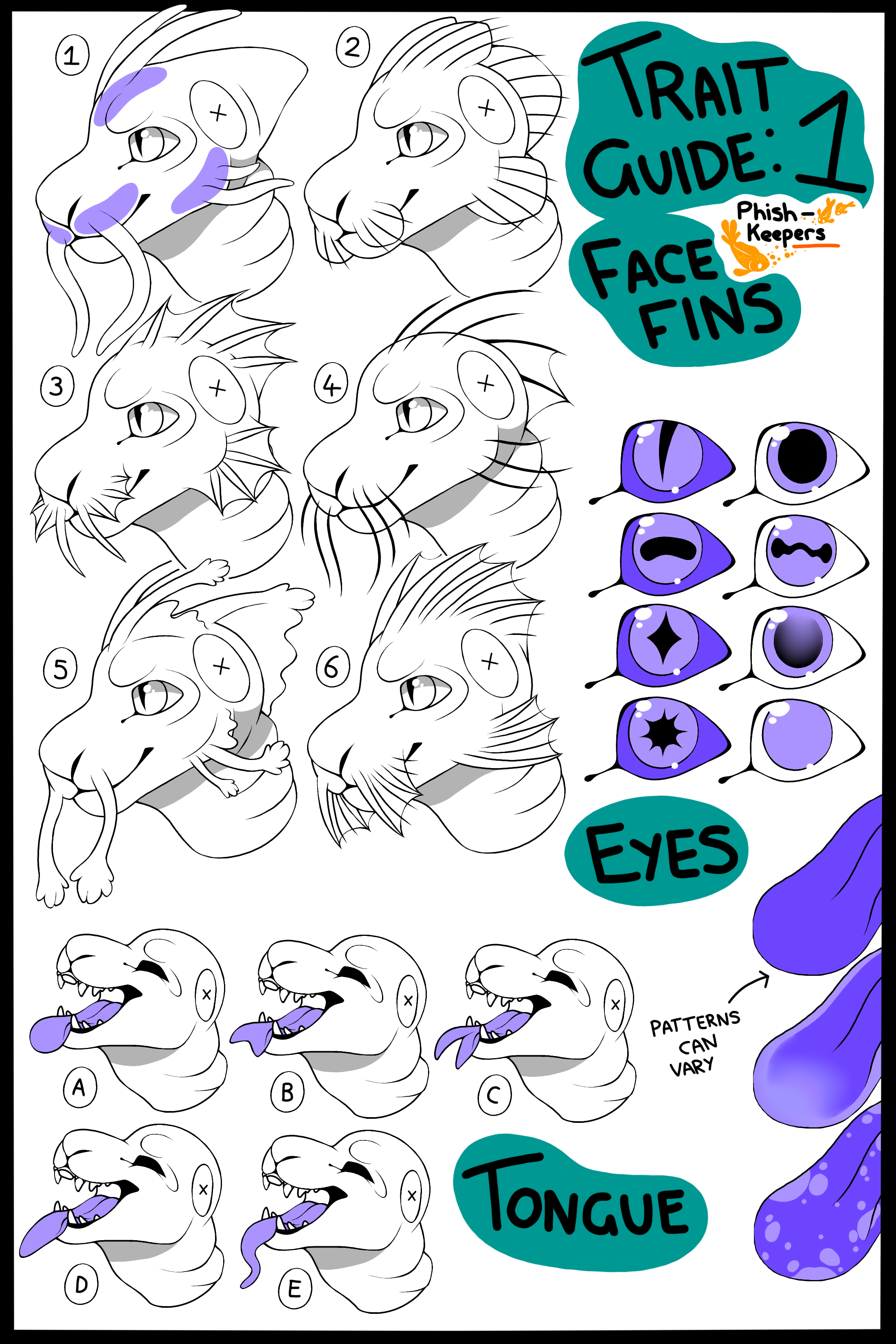
fACIAL fINS
1. Natural feelers - Labelled 1
These are the most common facial fin type amongst P-K and look like a short, medium or long length tendril, usually smooth in texture and moderately versatile. They can be both thick and thin, and can appear in singles, pairs or triplicate along the nerve line. (Indicated in light purple on the Guide sheet, see Image 1) Have limited maneuverability and tend to float around in the water when not being used to detect electrical signals.
These are the most common Feeler type, and can are the basis for all other fin types. As such, these feelers can even develop alongside other Feeler types on a Phish-Keepers face at the same time, creating a double up or overlap.
2. Round Fins - Labelled 2
These fins consist of a flat membrane surface, usually round or oval in shape, with thin, whisker-like fibres pointing outwards away from the face. Round fins are less maneuverable, but can wave back and forth to increase oxygen intake when in water.
Most commonly associated with round fin fish (both Tropical and Freshwater), seahorses, pufferfish and other similar species.
3. Internal Spine Fins - Labelled 3
Internal spine fins consist of straight, barb like feelers with pointed tips and a thin membrane surface stretching between each barb and between the first & last barb and the Phish-Keepers face. These fins can become quite large thanks to their added support columns between the fin membrane and the skull, and have a higher level of movement than most other fin types, including being able to fold back towards the body, fan in and out away from the face and lay flat against the skull instead of standing like normal.
Most commonly associated with Swordfish, Sailfish, Barracudas and other similar species.
4. Barbs - Labelled 4
Barbs are thin, elongated strands of electrical sensing fibres without any kin or muscle encasing like other Feeler types. These are the thinnest fin type most commonly found on the inside of Phish-Keeper ears, and facial fins of this type don’t have much use outside of their electrical sensing. Barbs tend to float around in the water and don’t move much on their own.
Most commonly associated with Catfish, Loaches, Bottom feeders and other small-sized similar species.
5. Fringed Fins - Labelled 5
These fins are more decorative than most, with a colorful fringe adorning the tips, sides and/or base of Standard feelers that flow with the current. These feelers have the same level of manoeuvrability and electro sensing as the Standard type.
Most commonly associated with smaller Tropical fish, Butterflyfish, Angelfish, Sea Slugs and other similar species.
6. External Spine Fins - Labelled 6
These fins are almost identical to Internal Spine fins, however then can only fan up and down against the skull. Have significant maneuverability and electro-sensing.
Most commonly associated with bigger Tropical Fish, Flyingfish, Lionfish, Sunfish, Tuna and other large-sized similar species.

Tongues / Eyes
Tongue Types:
- A. Round, most common type - See image labelled A
- B. Forked - See image labelled B
- C. Split - See image labelled C
- D. Pointed - See image labelled D
- E. Long - See image labelled E
Eye Types:
Phish-Keeper can have any colour of Iris, Sclera (the white part of the eye) and Dark colour pupils. They can also commonly have patterns of multiple colours throughout the Sclera and Iris, commonly stripes or spots.
- Standard Pupil types can include:
- Round pupils
- Slit pupils (Cat-like)
- Star/Pointed pupils
- Rounded horizontal slit pupils (Goat like)
- Diamond pupils
- Round faded pupils
- Octopus pupils (Wavy middle line with Rounded ends)
Other shapes may exist, but are not detailed on this Guide.
Various other natural mutation types may occur in the wild, and variations have a 50/50 chance of generating naturally when first morphing to their companions colours and features.
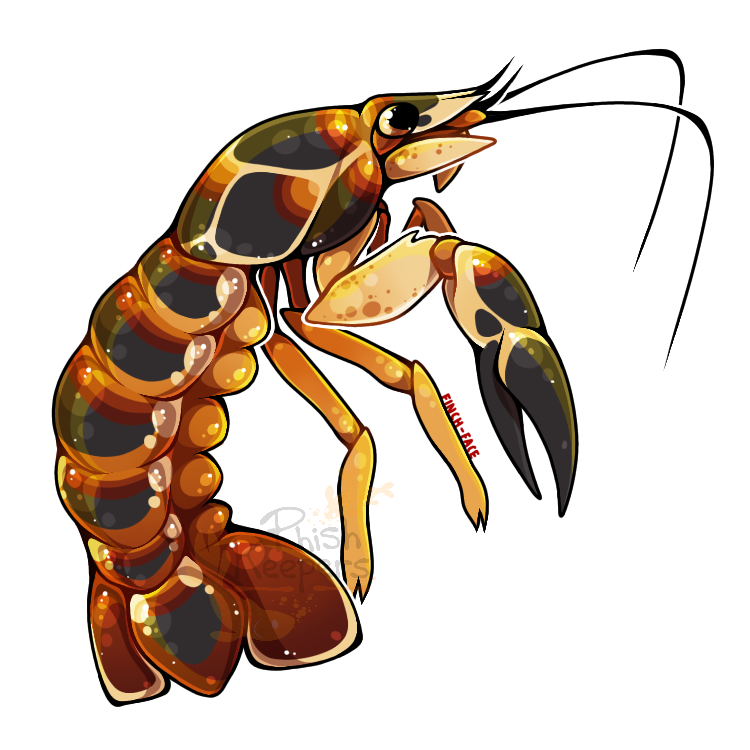
Companion
Companions are the animal a Phish-Keeper usually houses in their stomach pouch.
Companions are most commonly water dwelling creatures, such as fish, sharks, crustaceans, turtles, water mammals etc. Though the exact reasoning behind their unique symbiotic relationship is unknown, some believe that Phish-Keepers consider themselves as species preservationists as their presence can help to balance and sustain water-based ecosystems thanks to their relationship with their chosen Companion.
Companions fall into 3 types: Pouch dwelling, Semi-pouch dwelling, & Non-pouch dwelling.
Usually, if the animal is small enough to still fit into the pouch at full size, they are considered Pouch dwelling. If they are about the same size as the pouch, they are Semi-pouch dwelling, as they can still fit into the pouch if necessary though it is not the most comfortable for them or their P-K. The third type, Non-pouch dwelling, exists for larger creatures that do not stay at a small enough size to use the P-K’s pouch anymore, most commonly associated with species like sharks, dolphins, whales, some larger fish species etc.
Rarity types for Companion
Standard = Common:
- Most fish types
- Sharks
- Eels
- Crustaceans - Crabs, Lobsters, Shrimp
Special = Uncommon:
- Dolphins / Whales
- Beluga’s / Manatee
- Sea slugs / Flatworms
- Stingrays / Manta Rays
- Sea Snakes
- Crocodilians
- Turtles
Ultra = Rare:
- Sea snails
- Frogs / Newts
- Prehistoric Marine Creatures
- Marine Mammals
- Otters / Beavers / Penguins / Seals / Sea-lions / Walrus / etc.
Limited = Legendary:
- Fantasy Marine Creatures
- Sea-dragons, Mythical creatures, Folklore creatures, etc.
- Undead creatures
- Fandom related creatures
- Pokemon, Flight Rising, Game animals, etc.
All species commonly found in the Ocean, Rivers & streams of the world can become a companion for a P-K, without exception. The Companion of any Phish-Keeper directly influences their appearance, scale growth and colours.

accessories
In the wild, Phish-Keepers can pick up & use an abundance of natural materials & washed up items to personalize themselves, similar to how Landwalkers often wear different coloured cloth to make themselves look different! (And because they like to)
These accessories come in 3 different categories!
Manmade Items:
- Cloth (small scarves, bandana’s, handkerchiefs & other fabric items)
- Fishing gear (Hooks, rope, twine, fishing lures)
- Charms (bracelets, necklaces & other jewellery)
Natural Items:
- Shells
- Pearls
- Barnacles
- Seaglass
- Stones
- Coral
Plants:
- Seaweed

Phish-Keepers are a CLOSED SPECIES made and owned by FlNCH-FACE! Please DO NOT make your own Phish-Keeper without express permission, or as part of an MYO event!
Phish-Keepers are FlNCH-FACE‘s Intellectual Property and are protected by Digital Copyright. Any works featured in this Character Profile are made for the explicit use of the Species Lore, Scientific Conceptualization and World-building and are not permitted to be used outside of the Species World.
All respective property (Art, Literature, Characters, Lore, Concepts etc) made for this species by any party is subsequently added to the Phish-Keeper World, and is protected by the species’ Digital Copyright as long as it adheres to the Species Rules.